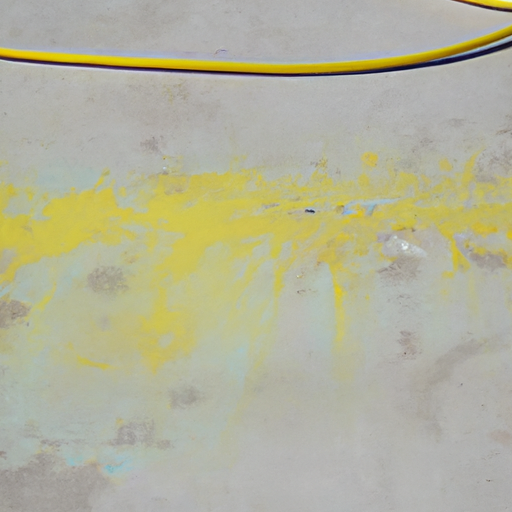In this article, you will explore the possibilities of spray painting a tarp and discover whether it is a viable option for your project. Painting on different surfaces has become increasingly popular in recent years, but the question remains: can you spray paint a tarp? As you delve into the topic, we will examine the necessary materials, the potential challenges, and the steps to effectively spray paint a tarp. Whether you’re a professional looking for innovative ways to enhance your work or a DIY enthusiast seeking to personalize your outdoor space, this article will provide valuable insights on the feasibility and techniques behind spray painting a tarp.
Preparing the Tarp for Spray Painting
Cleaning the Tarp
Before starting the spray painting process, it is crucial to ensure that the tarp is clean and free from any dust, dirt, or debris. Begin by gently shaking off any loose dirt from the surface of the tarp. Then, using a soft-bristled brush or a broom, sweep away any remaining particles.
Removing any Stains or Dirt
If there are any stubborn stains or dirt marks on the tarp, it is recommended to address them before proceeding with spray painting. Mix a mild detergent with water and gently scrub the stained areas using a sponge or a soft cloth. Rinse thoroughly with clean water to remove any soap residue. Allow the tarp to fully dry before moving on to the next step.
Drying the Tarp
After cleaning the tarp, it is important to allow it to dry completely. Hang the tarp in an airy and well-ventilated space, preferably outdoors, or use a fan to expedite the drying process. It is crucial to ensure that the tarp is completely dry before applying any spray paint to avoid uneven or blotchy results.
Choosing the Right Spray Paint

This image is property of images.unsplash.com.
Considering the Material of the Tarp
When selecting spray paint for a tarp, it is important to take into consideration the material it is made of. Different materials may require specific types of spray paint to achieve the desired results. For example, if the tarp is made of vinyl or PVC, it is recommended to use spray paint specifically designed for these materials.
Selecting the Appropriate Spray Paint Type
There are various types of spray paints available, each with its own properties and suitability for different surfaces. For tarp painting, it is advisable to choose spray paint that is designed for outdoor use and can withstand the elements. Look for spray paints that are labeled as weather-resistant or outdoor-friendly to ensure long-lasting results.
Checking for Compatibility
Before proceeding with spray painting, it is crucial to check the compatibility of the selected spray paint with the tarp material. Some spray paints may not adhere well to certain types of materials, leading to peeling or flaking. To avoid such issues, conduct a small compatibility test by applying a small amount of spray paint on a discreet area of the tarp and checking for any adverse reactions or poor adhesion.
Preparing the Spray Paint

This image is property of images.unsplash.com.
Shake the Spray Paint Can
Properly preparing the spray paint can is essential to ensure an even and smooth application. Before using the spray paint, vigorously shake the can for about a minute. This helps to mix the paint thoroughly and ensures that the color pigments are evenly distributed.
Testing the Spray Paint
Before applying the spray paint to the entire tarp, it is recommended to perform a test spray on a scrap piece of material or a small section of the tarp. This allows you to assess the paint’s consistency, coverage, and color accuracy. It is also an opportunity to get familiar with the spray nozzle and adjust the pressure if needed.
Using a Primer
Using a primer can significantly enhance the adhesion and durability of the spray paint on the tarp. A primer creates a smooth surface for the paint to adhere to and helps to prevent peeling or flaking over time. Apply a thin and even coat of primer onto the tarp, following the manufacturer’s instructions, and allow it to dry before applying the spray paint.
Spray Painting Techniques

This image is property of images.unsplash.com.
Selecting the Right Environment
Choosing the right environment for spray painting is crucial for achieving optimal results. Ideally, spray paint should be applied in a well-ventilated area. If possible, perform the spray painting outdoors to minimize the inhalation of fumes and ensure better ventilation. If working indoors, ensure proper ventilation by opening windows or using fans to circulate air.
Covering the Surrounding Area
Before starting the spray painting process, it is essential to protect the surrounding area from overspray. Cover any nearby objects, surfaces, or plants with drop cloths, plastic sheets, or newspapers. This will prevent any accidental damage or staining from the spray paint.
Applying Thin and Even Coats
To achieve a professional-looking finish, it is important to apply the spray paint in thin and even coats. Start by holding the can approximately 6 to 8 inches away from the tarp and move the can in smooth, sweeping motions. Avoid spraying too close or staying in one spot for too long, as this can result in uneven coverage, drips, or runs.
Executing the Spray Painting Process

Starting with a Base Coat
Begin the spray painting process by applying a base coat to the tarp. The base coat provides a foundation for the subsequent coats and helps to achieve a uniform color. Apply the base coat using the techniques mentioned earlier, ensuring full coverage of the tarp’s surface.
Maintaining the Recommended Distance
To achieve an even application and prevent oversaturation, it is important to maintain a consistent distance between the spray can and the tarp. Refer to the spray paint manufacturer’s guidelines for the recommended distance, as this can vary depending on the type of spray paint being used. This distance often ranges between 6 to 8 inches.
Using Smooth and Steady Strokes
When applying the spray paint, use smooth and steady strokes to achieve an even finish. Avoid abrupt movements or jerky motions, as this can result in streaks or uneven coverage. Practice moving the spray can in a controlled manner, keeping the strokes parallel to the tarp’s surface.
Allowing the Paint to Dry

Checking the Drying Time
After completing the spray painting process, it is crucial to allow the paint to dry fully before proceeding with any additional layers or sealing. The drying time can vary depending on factors such as humidity, temperature, and the type of paint used. Refer to the manufacturer’s instructions on the spray paint can for the recommended drying time.
Avoiding Touching or Disturbing the Paint
While the paint is drying, it is important to avoid touching or disturbing it to prevent smudging or smearing. Allow the tarp to dry in a safe and undisturbed area, away from any potential sources of dust or debris. Be patient and let the paint fully cure to ensure a durable and long-lasting finish.
Ensuring Sufficient Ventilation
During the drying process, it is essential to maintain proper ventilation to help expedite the drying time and disperse any lingering fumes. If the tarp is drying indoors, continue to keep the space well-ventilated by opening windows or using fans. If drying outdoors, ensure that the tarp is protected from dust, leaves, or any potential debris that may affect the paint’s surface.
Adding Additional Layers
Assessing the Need for Additional Coats
After the base coat has dried, assess the tarp’s appearance to determine if additional coats are necessary. This evaluation includes checking for any uneven areas, spots with poor coverage, or desired color intensity. If needed, proceed with additional coats to achieve the desired finish.
Applying Subsequent Coats
When applying subsequent coats of spray paint, follow the same application techniques used for the base coat. Remember to maintain consistent distance, use smooth strokes, and apply thin and even coats. Allow each coat to dry fully before applying the next one, following the manufacturer’s recommended drying time.
Allowing Each Coat to Dry
To ensure a professional and flawless finish, it is imperative to allow each coat of spray paint to dry completely before moving on to the next layer. Rushing the drying process can lead to smudging, uneven texture, or poor adhesion. Patience is key in achieving a high-quality and durable painted tarp.
Sealing and Protecting the Paint
Applying a Clear Protective Coat
Once the spray paint has fully dried and the desired number of coats has been applied, it is recommended to seal and protect the paint with a clear protective coat. This additional layer acts as a barrier against UV rays, moisture, and other potential damaging elements. Select a clear spray paint intended for outdoor use, and apply it following the same techniques used for the base coat.
Ensuring Adequate Drying Time
After applying the clear protective coat, allow the tarp sufficient time to dry before exposing it to any abrasive actions or adverse weather conditions. Follow the manufacturer’s instructions for the recommended drying time, ensuring that the tarp is fully cured for maximum protection and longevity.
Considering UV Protection
UV rays from the sun can cause the colors of the spray paint to fade over time. To minimize this effect, consider using a clear protective coat that offers UV protection. This will help to prolong the vibrancy and longevity of the paint on the tarp, ensuring that it retains its attractive appearance.
Maintaining and Cleaning the Painted Tarp
Avoiding Abrasive Cleaning Materials
To maintain the appearance and integrity of the painted tarp, it is important to avoid using abrasive cleaning materials that may damage the paint. Harsh brushes, scouring pads, or abrasive cleaners can scratch or strip away the paint layers. Opt for gentle cleaning methods to keep the painted tarp looking its best.
Using Gentle Soap and Water
For routine cleaning of the painted tarp, use a mild detergent or gentle soap mixed with water. Apply the solution to a soft sponge or cloth and gently scrub the surface of the tarp. Rinse thoroughly with clean water to remove any soapy residue and allow the tarp to air dry.
Storing the Tarp Properly
When not in use, it is important to store the painted tarp properly to prevent any damage or deterioration. Ensure that the tarp is clean and completely dry before folding or rolling it up. Store it in a cool, dry place away from direct sunlight to prevent fading or color distortion.
Safety Precautions
Working in a Well-Ventilated Area
When spray painting a tarp, it is crucial to work in a well-ventilated area to avoid inhaling fumes or chemicals. If spray painting indoors, open windows or use fans to ensure proper air circulation. If working outdoors, choose a location where fresh air is readily available.
Using Protective Gear
To protect yourself during the spray painting process, always wear appropriate personal protective equipment (PPE). This includes safety goggles or glasses to shield your eyes from overspray and a respiratory mask to prevent inhaling harmful fumes. Additionally, it is recommended to wear gloves to protect your hands from the paint and any potential irritants.
Avoiding Fire Hazards
Spray paints are flammable materials, and it is important to take precautions to avoid fire hazards. Avoid spraying near open flames, sparks, or any potential sources of ignition. Keep the spray paint cans away from heat sources and store them in a cool and dry area. Always read and follow the safety instructions provided by the spray paint manufacturer to ensure safe handling and storage.
In conclusion, spray painting a tarp can be a rewarding process that allows for creativity and customization. By following the steps outlined in this article, you can prepare the tarp, choose the right spray paint, execute the painting, and properly maintain the finished product. Remember to prioritize safety, select the appropriate materials, and follow the manufacturer’s instructions for the best results. Whether used for artistic purposes or practical applications, a spray-painted tarp can add a unique touch to any project or outdoor space.



